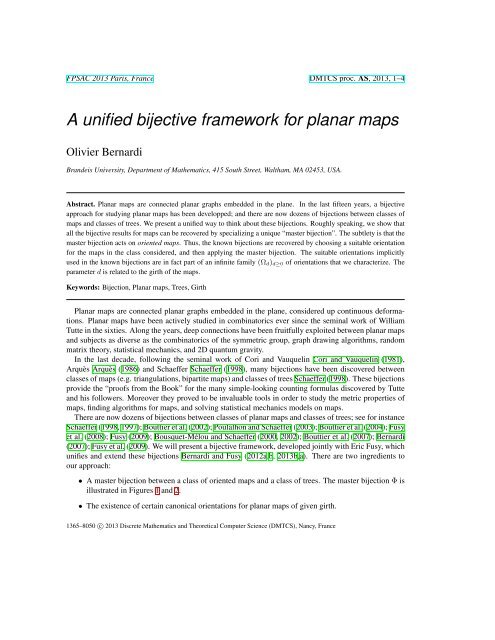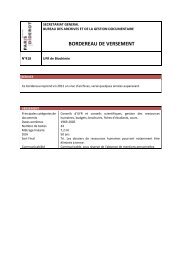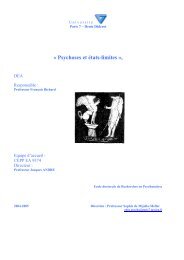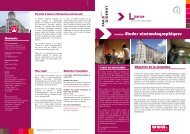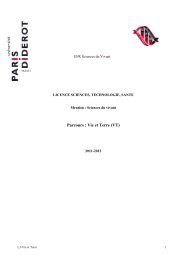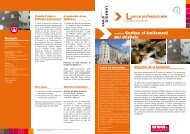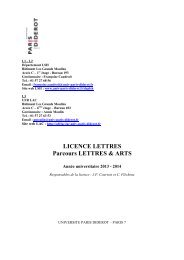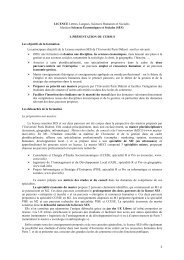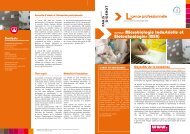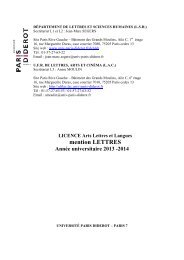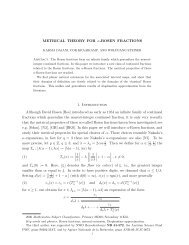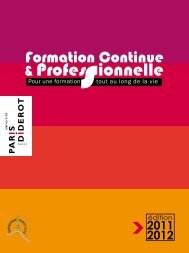A unified bijective framework for planar maps - liafa
A unified bijective framework for planar maps - liafa
A unified bijective framework for planar maps - liafa
Create successful ePaper yourself
Turn your PDF publications into a flip-book with our unique Google optimized e-Paper software.
FPSAC 2013 Paris, France DMTCS proc. AS, 2013, 1–4<br />
A <strong>unified</strong> <strong>bijective</strong> <strong>framework</strong> <strong>for</strong> <strong>planar</strong> <strong>maps</strong><br />
Olivier Bernardi<br />
Brandeis University, Department of Mathematics, 415 South Street, Waltham, MA 02453, USA.<br />
Abstract. Planar <strong>maps</strong> are connected <strong>planar</strong> graphs embedded in the plane. In the last fifteen years, a <strong>bijective</strong><br />
approach <strong>for</strong> studying <strong>planar</strong> <strong>maps</strong> has been developped; and there are now dozens of bijections between classes of<br />
<strong>maps</strong> and classes of trees. We present a <strong>unified</strong> way to think about these bijections. Roughly speaking, we show that<br />
all the <strong>bijective</strong> results <strong>for</strong> <strong>maps</strong> can be recovered by specializing a unique “master bijection”. The subtlety is that the<br />
master bijection acts on oriented <strong>maps</strong>. Thus, the known bijections are recovered by choosing a suitable orientation<br />
<strong>for</strong> the <strong>maps</strong> in the class considered, and then applying the master bijection. The suitable orientations implicitly<br />
used in the known bijections are in fact part of an infinite family (Ω d ) d≥0 of orientations that we characterize. The<br />
parameter d is related to the girth of the <strong>maps</strong>.<br />
Keywords: Bijection, Planar <strong>maps</strong>, Trees, Girth<br />
Planar <strong>maps</strong> are connected <strong>planar</strong> graphs embedded in the plane, considered up continuous de<strong>for</strong>mations.<br />
Planar <strong>maps</strong> have been actively studied in combinatorics ever since the seminal work of William<br />
Tutte in the sixties. Along the years, deep connections have been fruitfully exploited between <strong>planar</strong> <strong>maps</strong><br />
and subjects as diverse as the combinatorics of the symmetric group, graph drawing algorithms, random<br />
matrix theory, statistical mechanics, and 2D quantum gravity.<br />
In the last decade, following the seminal work of Cori and Vauquelin Cori and Vauquelin (1981),<br />
Arquès Arquès (1986) and Schaeffer Schaeffer (1998), many bijections have been discovered between<br />
classes of <strong>maps</strong> (e.g. triangulations, bipartite <strong>maps</strong>) and classes of trees Schaeffer (1998). These bijections<br />
provide the “proofs from the Book” <strong>for</strong> the many simple-looking counting <strong>for</strong>mulas discovered by Tutte<br />
and his followers. Moreover they proved to be invaluable tools in order to study the metric properties of<br />
<strong>maps</strong>, finding algorithms <strong>for</strong> <strong>maps</strong>, and solving statistical mechanics models on <strong>maps</strong>.<br />
There are now dozens of bijections between classes of <strong>planar</strong> <strong>maps</strong> and classes of trees; see <strong>for</strong> instance<br />
Schaeffer (1998, 1997); Bouttier et al. (2002); Poulalhon and Schaeffer (2003); Bouttier et al. (2004); Fusy<br />
et al. (2008); Fusy (2009); Bousquet-Mélou and Schaeffer (2000, 2002); Bouttier et al. (2007); Bernardi<br />
(2007); Fusy et al. (2009). We will present a <strong>bijective</strong> <strong>framework</strong>, developed jointly with Eric Fusy, which<br />
unifies and extend these bijections Bernardi and Fusy (2012a,b, 2013b,a). There are two ingredients to<br />
our approach:<br />
• A master bijection between a class of oriented <strong>maps</strong> and a class of trees. The master bijection Φ is<br />
illustrated in Figures 1 and 2.<br />
• The existence of certain canonical orientations <strong>for</strong> <strong>planar</strong> <strong>maps</strong> of given girth.<br />
1365–8050 c○ 2013 Discrete Mathematics and Theoretical Computer Science (DMTCS), Nancy, France
2 Olivier Bernardi<br />
Fig. 1: The three types of edges in a bi-oriented map and the local rule of the master bijection Φ.<br />
Fig. 2: The master bijection Φ applied to a bi-oriented map: the image is a tree with black and white vertices with<br />
some decorations on black vertices.<br />
References<br />
D. Arquès. Les hypercartes planaires sont des arbres très bien étiquetés. Discrete math., 58(1):11–24,<br />
1986.<br />
O. Bernardi. Bijective counting of tree-rooted <strong>maps</strong> and shuffles of parenthesis systems. Electron. J.<br />
Combin., 14(1):R9, 2007. ISSN 1077-8926.<br />
O. Bernardi and E. Fusy. A bijection <strong>for</strong> triangulation, <strong>for</strong> quadrangulation, <strong>for</strong> pentagulation, etc. J.<br />
Combin. Theory Ser. A, 119(1), 2012a.<br />
O. Bernardi and É. Fusy. Unified bijections <strong>for</strong> <strong>maps</strong> with prescribed degrees and girth. J. Combin. Theory<br />
Ser. A, 119:1351–1387, 2012b.<br />
O. Bernardi and E. Fusy. A master bijection <strong>for</strong> hyper<strong>maps</strong>. In preparation., 2013a.<br />
O. Bernardi and E. Fusy. Unified bijections <strong>for</strong> irreducible <strong>maps</strong>. In preparation., 2013b.<br />
M. Bousquet-Mélou and G. Schaeffer. Enumeration of <strong>planar</strong> constellations. Adv. in Appl. Math., 24(4):<br />
337–368, 2000.<br />
M. Bousquet-Mélou and G. Schaeffer. The degree distribution in bipartite <strong>planar</strong> <strong>maps</strong>: application to the<br />
Ising model. In FPSAC, 2002. See also ArXiv: math.CO/0211070.
Bijective <strong>framework</strong> <strong>for</strong> <strong>planar</strong> <strong>maps</strong> 3<br />
J. Bouttier, P. Di Francesco, and E. Guitter. Census of <strong>planar</strong> <strong>maps</strong>: from the one-matrix model solution<br />
to a combinatorial proof. Nuclear Phys., B 645:477–499, 2002.<br />
J. Bouttier, P. Di Francesco, and E. Guitter. Planar <strong>maps</strong> as labeled mobiles. Electron. J. Combin., 11(1):<br />
R69, 2004.<br />
J. Bouttier, P. Di Francesco, and E. Guitter. Blocked edges on eulerian <strong>maps</strong> and mobiles: Application to<br />
spanning trees, hard particles and the Ising model. J. Phys. A, 40(27):7411–7440, 2007.<br />
R. Cori and B. Vauquelin. Planar <strong>maps</strong> are well labeled trees. Canad. J. Math., 33(5):1023–1042, 1981.<br />
E. Fusy. Transversal structures on triangulations: a combinatorial study and straight-line drawings. Discrete<br />
Math., 309:1870–1894, 2009.<br />
E. Fusy, D. Poulalhon, and G. Schaeffer. Dissections, orientations, and trees, with applications to optimal<br />
mesh encoding and to random sampling. Transactions on Algorithms, 4(2):Art. 19, 2008.<br />
E. Fusy, D. Poulalhon, and G. Schaeffer. Bijective counting of plane bipolar orientations. Europ. J.<br />
Combin., 30, 2009.<br />
D. Poulalhon and G. Schaeffer. A bijection <strong>for</strong> triangulations of a polygon with interior points and multiple<br />
edges. Theoret. Comput. Sci., 307(2):385–401, 2003.<br />
G. Schaeffer. Bijective census and random generation of Eulerian <strong>planar</strong> <strong>maps</strong> with prescribed vertex<br />
degrees. Electron. J. Combin., 4(1):# 20, 14 pp., 1997.<br />
G. Schaeffer. Conjugaison d’arbres et cartes combinatoires aléatoires. PhD thesis, Université Bordeaux<br />
I, 1998.
4 Olivier Bernardi


